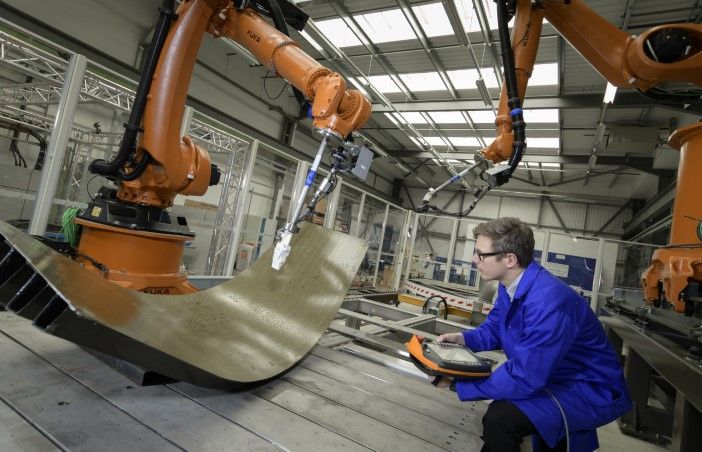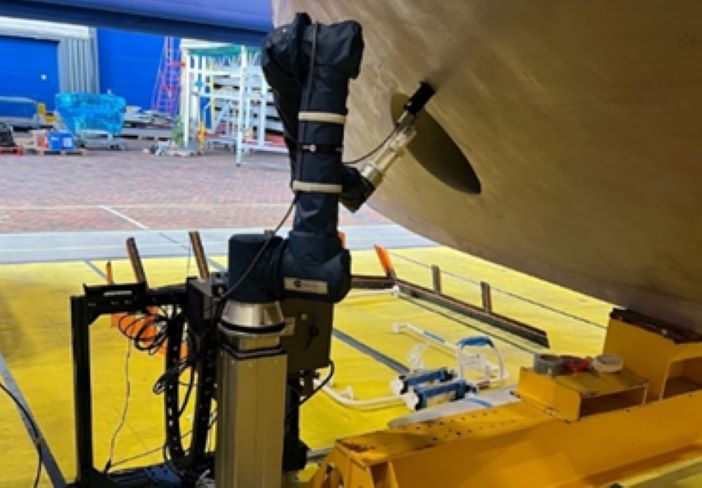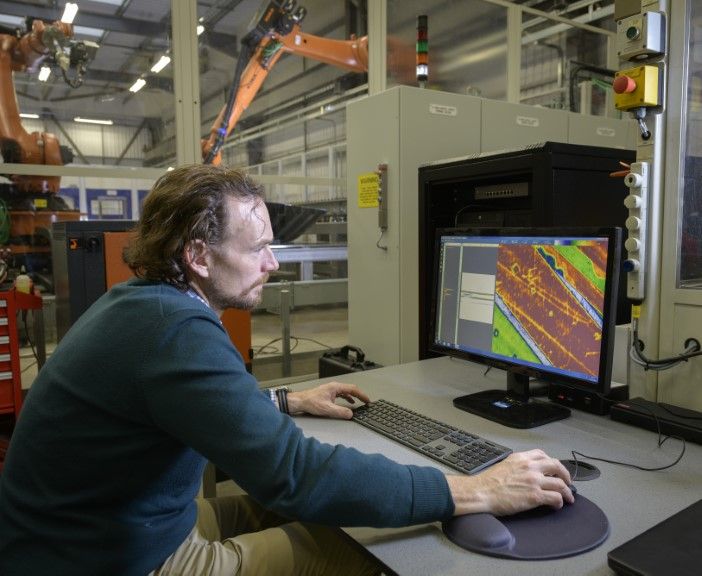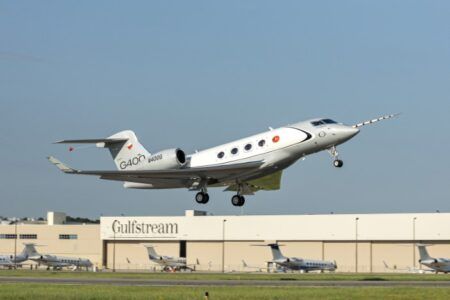Nondestructive testing in aerospace is evolving rapidly, driven by the needs for higher accuracy and faster inspection cycles, as well as a drive to improve repeatability in manufacturing.
Simultaneously meeting commercial objectives, sustainability, and climate change goals while ensuring safety and reliability is a tough challenge for aerospace companies. Faced with these and other pressures, many aerospace nondestructive testing (NDT) practitioners are turning to integrating robotic systems with advanced software in order to refine and automate inspection processes.
UK-based research and technology company TWI, a subsidiary of The Welding Institute is perhaps best known for the engineering training it provides. One of TWI’s core competencies is materials performance for which it has a center of excellence at its Technology Centre in Port Talbot, Wales.
Nathan Hartley is the section manager for NDT research and technology at TWI’s Technology Centre. He says, “We are supporting our members by helping them improve inspection resolution and accuracy, to reduce inspection and analysis times, to improve the reliability and repeatability of those inspections.”
Saving time while improving accuracy and reliability are the stated aims of almost all automation projects. Likewise, the key question before any project is started is how much time will automating a process save. How much more accurate can the use of robots and software make measurements?
“It depends. On the component, on the materials, what you’re looking for, the resolution and the size of defect you’re trying to find,” says Hartley. “A recent test piece given to us was a curved carbon fiber winglet component. We achieved a nine times reduction in time to inspect that component with robotics compared to the manual inspection. That gives you a rough idea of what’s possible.”
Robotic cells
TWI operates two large industrial robotic cells dedicated to aerospace component inspections. The systems are equipped with KUKA robotic arms mounted on tracks. This extends the inspection volume and allows for flexible configurations of the equipment.
“We can inspect up to a twelve by three by three-meter volume,” says Hartley. “We also have a turntable that is around four meters in diameter with a one-ton weight capacity.”
The setup enables the efficient scanning of large or geometrically complex structures, ensuring consistent data collection. The robotic systems also provide an advantage over manual inspection by eliminating variability and increasing repeatability. Where manual inspections can be time-consuming and subject to human error, a robotic system can execute pre-programmed scans with precision. This is especially crucial for applications in the aerospace sector, where defects in composite and metallic structures can compromise safety.

Expanding robotic inspection
One of the key drivers of robotic NDT adoption is the increasing complexity of aerospace materials and components.
“As we see more carbon fiber and more additive manufacturing processes being used in aerospace, larger structures with more complex geometries, the much more challenging materials have necessitated the use of robotics,” Hartley says. “Innovation only seems to go in one direction from an inspection point of view. It makes it harder.”
Glass fiber is notoriously difficult to inspect with ultrasonic testing (UT), because each different layer refracts the signal, while big fibers can cause a lot of noise and a poor signal-to-noise ratio. Aerospace applications also use a lot of honeycomb-type core materials, and ultrasonics don’t travel very well through the air.
Some modern fuselages also have sections that use layers of viscoelastic sound-deadening materials, specifically designed to absorb sound. “Inspecting that with sound can present several challenges,” says Hartley.
“We have done some work with laser UT. It’s an interesting inspection method because it allows very high accuracy. It’s non-contact and rapid. We have penetrated some really challenging material, sometimes with acoustic deadening material within it.
“One of the things that’s very difficult with laser UT is getting the right balance of energy into the part without damaging it.”
TWI’s robotic systems are modular and designed to accommodate a variety of NDT techniques. As well as UT, they use phased array ultrasonic testing (PAUT), eddy current testing, microwave inspection, digital radiography, and even laser ultrasonics.
“We are also able to do coupled UT, pulse echo and through transmission,” says Hartley. “Where you have got very attenuative materials, sometimes it is not possible to inspect those with pulse echo. If there’s access to both sides, then we will do through transmission inspection.”
Beyond fixed robotic cells, TWI is also developing mobile and collaborative robotic solutions (Cobots) for site deployable inspections. “Where you have structures that are too large to bring to the robot cell, we can take the robot to the structure instead,” says Hartley.
Cobots offer a significant advantage in a confined or hazardous environment. “They are specifically designed to work alongside humans. You don’t need fixed safety guarding around the outside, and we can work right next to them,” Hartley says.
An example of this adaptability is TWI’s work with large fuselage sections, where automated systems perform ultrasonic inspections at height, reducing the need for scaffolding and manual labor. This improves safety while expediting the inspection process.
The capability to deploy Cobots in aircraft hangars or production lines also ensures minimal disruption to operations, a key factor in aerospace manufacturing.

Software to enhance hardware
The effectiveness of robotic inspection is determined not just by the hardware but also by the software that drives it. TWI has developed its own custom-built software, the TWI Crystal Software Development Kit (SDK) for NDT robotic inspection applications. The SDK provides an integrated environment for data acquisition, visualization, and analysis.
“The SDK consists of three main layers – a user interface layer, a data layer, and an acquisition layer,” explains Mark Sutcliffe, consultant for NDT Software at TWI. “This approach is very efficient, as it supports rapid application development. In some instances, it may only take a few days to incorporate a new NDT inspection device.”
A key innovation within the software is the ability to merge 3D scanning data with ultrasonic feedback to dynamically adjust the inspection path. “Because this acquisition is independent of the CAD used for path planning, you can also use the UT signal itself as a metrology system,” Sutcliffe says.
This capability is useful when dealing with deviations from nominal CAD models, which is a common issue that occurs in aerospace composite manufacturing. The software’s ability to integrate multiple NDT techniques is also valuable because it allows for data fusion.
So for example, ultrasonic results can be overlaid with digital radiography images or eddy current scans, creating a comprehensive picture of component integrity.
Challenges in path planning
Path planning remains a significant challenge in robotic NDT, says Sutcliffe. “When we first started development into robotic NDT, there were no tools available for us to do path planning, so we had to build it from scratch.
“There still aren’t that many options for NDT solutions. The typical approach is to take the CAD of the component, break this down into a series of manageable areas, and overlay a raster pattern.”
However, this method does not always allow for defect-oriented probe positioning. To address this, TWI has developed a semi-automated process that does not require expert robotic programming knowledge.
“The user touches several points on the surface with a robot,” Sutcliffe says. “The SDK then generates a crude 3D CAD of that component and automatically projects a raster path onto that surface. The user selects a preferred orientation, and from there, scanning starts immediately.”
This automation significantly reduces the time required to set up inspections, improving overall efficiency.

AI for defect recognition
Artificial intelligence (AI) and machine learning (ML) are starting to play a role in the implementation of NDT technologies, particularly in areas such as defect recognition and path planning. However, challenges remain before its use can become widespread.
“One of the challenges with NDT and applying AI to it is the lack of training data,” says Sutcliffe. “Nine times out of ten, you are inspecting parts expecting them to be good. So, it is very difficult to get access to sufficient training data.”
Despite this, AI-driven inspection planning is a promising area. Sutcliffe says, “The idea is to have a robotic platform that drives up to a structure, performs the inspection autonomously, and applies self-driving AI algorithms to that process. That’s where we see the shorter term goal for AI application.”
With ongoing developments in AI, automation, and new NDT techniques, the future of aerospace inspection is increasingly defined by robotics and intelligent software. Hartley says, “We like to think that we are on the cutting edge of research at TWI. The challenges ahead are significant, but so are the opportunities.”
As TWI expands its capabilities, the combination of robotics and sophisticated software solutions ensures aerospace manufacturers can meet stringent safety and quality requirements efficiently. This continuous innovation is positioning robotic NDT as an essential tool for the next generation of aircraft and spacecraft manufacturing.





